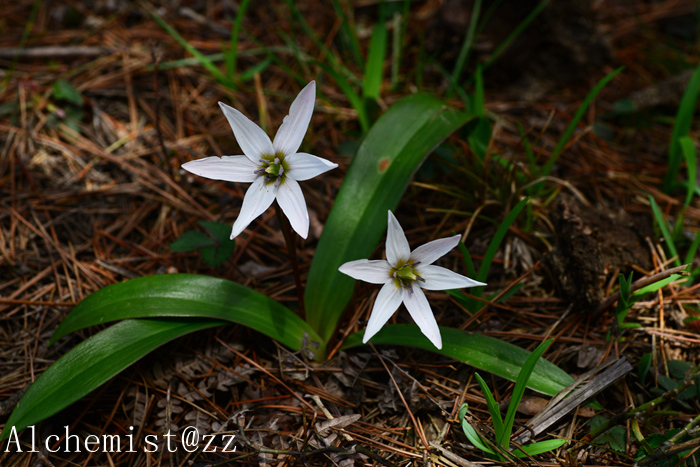- Scientific Name: Amana kuocangshanica D.Y.Tan & D.Y.Hong
- Ref: Bot. J. Linn. Soc. 154:437. 2007
- Chinese Common Name: 括苍山老鸦瓣 Kuòcāng Shān lǎoyā∙bàn
- Family: Liliaceae
- Genus: Amana
- Distribution: confined to Mt. Kuocang, Zhejiang Province, south-east China, where a large amount of individuals were seen in bamboo forests or in bushes at an altitude of 600–1100 m. It grows in moist places.
- Photo: 03/28/2015, Mt. Kuocang, Zhejiang
Perennial herbs; bulbs ovoid, 9–15(−19) mm in diameter; tunics yellow-brownish, thinly papery, glabrous inside. Stems (95–)118–200 mm tall, glabrous, simple. Leaves two, dark green or purplish-green, opposite, oblanceolate; the lower leaf 114–250 × 8–23 mm, with the widest part at two-thirds length from the base, the upper 104–245 × 4.5–11 mm. Bracts usually three, whorled, narrowly lanceolate, green or purple, 27–42 × 2.0–3.0 mm; pedicels 12–51 mm. Flowers solitary, funnel-shaped, tepals six, white, with a deep green or yellowish-green blotch at the very base inside and brownish-purple streaks on the back; outer tepals lanceolate, acute, 21–37 × 4–8 mm; inner tepals narrow elliptic, bluntly acute, 15–34 × 6–11 mm. Stamens six, the inner three slightly longer than the outer; filaments 4.0–6.5 × 1.5–2.0 mm, yellow, proximally dilated, gradually attenuate towards apex, glabrous; anthers 4.0–7.0(−10.0) × (1.0–)1.5–1.8 mm, purplish-brown with deep purple margins. Ovaries yellowish-green, constricted below the style, 4.0–8.0 mm, styles 4.0–6.0 mm. Fruits triquetrous, 10–14 × 11–15 mm, the fruiting beak 5–7.5 mm. Flowers in February–March and fruits in April–May. (Bot. J. Linn. Soc. 154:437)
